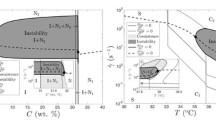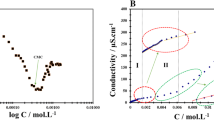Abstract
Rheological measurements on aqueous solutions containing a constant concentration of cetyltrimethylammonium bromide and increasing the concentration of counter ion additive, M2X, where X 2− represents 4-methoxysalicylate (4-MeOSa2−) and 3-, 4-methylsalicylate (3-, 4-MeSa2−), exhibit the presence of (i) spherical (SM), wormlike (WM) and branched (BWM) micelles for X 2− = 4-MeOSa2− and (ii) spherical, wormlike, branched micelles, small vesicles (SVs)/planar bilayer sheets (PBLS) and multilamellar vesicles (MLV) for X 2− = 3-, 4-MeSa2−. Zero shear viscosities measured with respect to M2X showed first and second maxima which were used to calculate flow activation energies (E a) at various M2X.







Similar content being viewed by others
References
Abdel-Rahem R, Hoffmann H (2007) Novel viscoelastic systems from cationic surfactants and hydrophobic counterions: influence of surfactant chain length. J Colloid Interface Sci 312:146–156
Borak JB, Lee HY, Raghavan SR, Falvey D (2010) Application of photoinduced electron transfer (PET) deprotection for orthogonal photocontrol of aqueous solution viscosity. Chem Commun 46:8983–8985
Carver M, Smith TL, Gee JC, Delichere A, Caponetti E, Magid LJ (1996) Tuning of micellar structure and dynamics in aqueous salt-free solutions of cetyltrimethylammonium mono- and dichlorobenzoates. Langmuir 12:691–698
Cassidy MA, Warr GG (1996) Surface potentials and ion binding in tetradecyltrimethylammonium bromide/sodium salicylate micellar solutions. J Phys Chem 100:3237–3240
Cates ME (1990) Nonlinear viscoelasticity of wormlike micelles (and other reversibly breakable polymers). J Phys Chem 94:371–375
Davies TS, Ketner AM, Raghavan SR (2006) Self-assembly of surfactant vesicles that transform into viscoelastic wormlike micelles upon heating. J Am Chem Soc 128:6669–6675
Dreiss CA (2007) Wormlike micelles: where do we stand? Recent developments, linear rheology and scattering techniques. Soft Matter 3:956–970
Ge W, Shi H, Zakin JL (2012) Rheo-optics of cationic surfactant micellar solutions with mixed aromatic counterions. Rheol Acta 51:249–258
Gradzielski M (2011) The rheology of vesicle and disk systems—relation between macroscopic behavior and microstructure. Curr Opinion Colloid Interfaces Sci 16:13–17
Israelachvili JN, Mitchell DJ, Ninham BW (1976) Theory of self-assembly of hydrocarbon amphiphiles into micelles and bilayers. J Chem Soc Faraday Trans 2(72):1525–1568
Kawasaki H, Imahayashi R, Maeda H (2002) Effects of hydrophobic counterions on the phase behavior of tetradecyldimethylhydroxylammonium chloride in aqueous solutions. Langmuir 18:8358–8363
Ketner AM, Kumar R, Davies TS, Elder PW, Raghavan SR (2007) A simple class of photorheological fluids: surfactant solutions with viscosity tunable by light. J Am Chem Soc 129:1553–1559
Khan MN (2010) A new semi-empirical kinetic method for the determination of ion exchange constants for the counterions of cationic micelles. Adv Colloid Interfaces Sci 159:160–179
Khan MN, Ismail E, Yusof NSM (2010) A new empirical kinetic method for the determination of ion-exchange constants for the counterions of cationic micelles: the rate of piperidinolysis and hydrolysis of anionic phenyl salicylate as the kinetic probes. Colloids Surf A 361:150–161
Koshy P, Verma G, Aswal VK, Venkatesh M, Hassan PA (2010) Viscoelastic fluids originated from enhanced solubility of sodium laurate in cetyltrimethylammonium bromide micelles through cooperative self-assembly. J Phys Chem B 114:10462–10470
Lin Z, Cai JJ, Scriven LE, Davis HT (1994) Spherical-to-wormlike micelle transition in CTAB solutions. J Phys Chem 98:5984–5993
Macosko CW (1994) Rheology: principles, measurements, and applications (VCH, New York
Magid LJ, Han Z, Warr GG, Cassidy MA, Butler PW, Hamilton WA (1997) Effect of counterion competition on micellar growth horizons for cetyltrimethylammonium micellar surfaces: electrostatics and specific binding. J Phys Chem B 101:7919–7927
Menger FM, Williams DY, Underwood AL, Anacker EW (1982) Effect of counterion geometry on cationic micelles. J Colloid Interface Sci 90:546–548
Mitchell DJ, Ninham BW (1981) Micelles, vesicles, and microemulsions. J Chem Soc Faraday Trans 2(77):601–629
Morariu S, Bercea M (2012) Effect of temperature and aging time on the rheological behavior of aqueous poly(ethylene glycol)/laponite RD dispersions. J Phys Chem B 116:48–54
Muriga S, Monduzzi M, Palazzo G (2012) Quantification of specific anion binding to non-ionic Triton X-100 micelles. Langmuir 28:1283–1289
Oelschlaeger C, Schopferer M, Scheffold F, Willenbacher N (2009) Linear-to-branched micelle transition: a rheometry and diffusing wave spectroscopy (DWS) study. Langmuir 25:716–723
Oelschlaeger C, Schopferer M, Scheffold F, Willenbacher N (2010) Effect of counterion binding efficiency on structure and dynamics of wormlike micelles. Langmuir 26:7045–7053
Raghavan SR, Kaler EW (2001) Highly viscoelastic wormlike micellar solutions formed by cationic surfactants with long unsaturated tails. Langmuir 17:300–306
Raghavan SR, Edlund H, Kaler EW (2002) Cloud-point phenomena in wormlike micellar systems containing cationic surfactant and salt. Langmuir 18:1056–1064
Rao URK, Manohar C, Valaulikar BS, Iyer RM (1986) On the origin of viscoelasticity in micellar solutions of cetyltrimethylammonium bromide and sodium salicylate. J Chem Soc, Chem Commun 379–381
Rao URK, Manohar C, Valaulikar BS, Iyer RM (1987) Micellar chain model for the origin of the viscoelasticity in dilute surfactant solutions. J Phys Chem 91:3286–3291
Razak NA, Khan MN (2013) Determination of flow activation energy at viscosity maximum for spherical and wormlike micelles of different lengths and flexibility. Rheol Acta 52:927–937
Razak NA, Khan MN (2014) Kinetics and mechanism of nanoparticles-catalyzed piperidinolysis of anionic phenyl salicylate. Sci World J 604139:1–7. doi:10.1155/2014/604139
Rehage H, Hoffmann H (1991) Viscoelastic surfactant solutions: model systems for rheological research. Mol Phys 74:933–973
Romsted LS (2007) Do amphiphile aggregate morphologies and interfacial compositions depend primarily on interfacial hydration and ion-specific interactions? the evidence from chemical trapping. Langmuir 23:414–424
Shikata T, Hirata H, Kotaka T (1989) Micelle formation of detergent molecules in aqueous media. 3. Viscoelastic properties of aqueous cetyltrimethylammonium romide-salicylic acid solutions. Langmuir 5:398–405
Sreejith L, Parathakkat S, Nair SM, Kumar S, Varma G, Hassan PA, Talmon Y (2011) Octanol-triggered self-assemblies of the CTAB/KBr system: a microstructural study. J Phys Chem B 115:464–470
Staurt MCA, Boekema EJ (2007) Two distinct mechanisms of vesicle-to-micelle and micelle-to-vesicle transition are mediated by the packing parameter of phospholipid-detergent systems. Biochim Biophys Acta 1768:2681–2689
Vermathen M, Stiles P, Bachofer SJ, Simonis U (2002) Investigation of monofluoro-substituted benzoates at the tetradecyltrimethylammonium micellar interface. Langmuir 18:1030–1042
Yusof NSM, Khan MN (2012) Quantitative correlation of counterion (X) affinity to ionic micelles and X- and temperature-induced micellar growth (spherical-wormlike micelles-vesicles) for X = 5-methyl- and 5-methoxysalicylate ions. J Phys Chem B 116:2065–2074
Zhang J, Liu S (2011) Kinetics of thermo-induced micelle-to-vesicle transitions in a catanionic surfactant system investigated by stopped-flow temperature jump. Phys Chem Chem Phys 13:12545–12553
Zheng Y, Lin Z, Zakin JL, Talmon Y, Davis HT, Scriven LE (2000) Cryo-TEM imaging the flow-induced transition from vesicles to threadlike micelles. J Phys Chem B 104:5263–5271
Ziserman L, Abezgauz L, Ramon O, Raghavan SR, Danino D (2009) Origins of the viscosity peak in wormlike micellar solutions. 1. Mixed catanionic surfactants. A cryo-transmission electron microscopy study. Langmuir 25:10483–10489
Acknowledgments
We thank the Ministry of Higher Education (MOHE) and University of Malaya (UM) for the financial assistance through research grants UM.C/HIR/MOHE/SC/07.
Author information
Authors and Affiliations
Corresponding author
Electronic supplementary material
Below is the link to the electronic supplementary material.
ESM 1
(DOC 437 kb)
Rights and permissions
About this article
Cite this article
Razak, N.A., Yusof, N.S.M. & Khan, M.N. Rheological study on counter ion (X 2−)- and temperature-induced cationic micellar growth: a quantitative correlation between X 2− binding affinity to cationic micelles and X 2−- and temperature-induced micellar growth. Rheol Acta 55, 125–136 (2016). https://doi.org/10.1007/s00397-015-0899-y
Received:
Revised:
Accepted:
Published:
Issue Date:
DOI: https://doi.org/10.1007/s00397-015-0899-y




